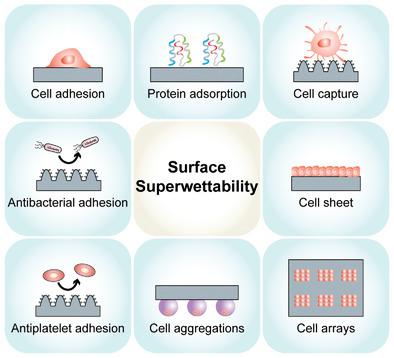当前位置:
X-MOL 学术
›
Small Methods
›
论文详情
Our official English website, www.x-mol.net, welcomes your
feedback! (Note: you will need to create a separate account there.)
Superwettable Surface Engineering in Controlling Cell Adhesion for Emerging Bioapplications
Small Methods ( IF 10.7 ) Pub Date : 2020-09-13 , DOI: 10.1002/smtd.202000573 Haijun Cui 1 , Wenshuo Wang 1 , Lianxin Shi 1 , Wenlong Song 2 , Shutao Wang 1, 3
Small Methods ( IF 10.7 ) Pub Date : 2020-09-13 , DOI: 10.1002/smtd.202000573 Haijun Cui 1 , Wenshuo Wang 1 , Lianxin Shi 1 , Wenlong Song 2 , Shutao Wang 1, 3
Affiliation

|
The dynamic liquid environment of live cells makes it necessary to consider the surface wettability when designing biomaterials and related devices. Especially superwettability, as the extreme state of wettability, has become a unique platform for regulating cell behaviors elaborately including adhesion, spreading, proliferation, differentiation, and apoptosis, which elicits the promising applications on biomedicine and advanced biodevices. In this review, the controlling cell adhesion on superwettable engineering surfaces is summarized. Next, the related bioapplications utilizing the surface superwettability are recapitulated, including reversible surface wettability for cell capture/adhesion, superwettability‐based patterns for cell arrays/aggregations construction, superwettability for antiplatelet adhesion, and superwettable surfaces as antimicrobial materials. Several design concepts are concluded on the emerging bioapplications of superwettable surface. Although so many efforts have been made for revealing the mechanism of cell functions on the superwettable surface, the complexity and variability between superwettable surface and liquid environment in physiological activities of organisms still requires impeccable theories, and the remaining unclear mechanisms of superwettability for biological systems are also discussed. As an outlook, the surface superwettability is just beginning to demonstrate its great potential in biology, offering great opportunities in tissue engineering, implantable devices, biosensors, drug‐screening, and cancer diagnostics.
中文翻译:

控制生物粘附的新兴生物应用中的超湿表面工程
活细胞的动态液体环境使得在设计生物材料和相关设备时必须考虑表面润湿性。尤其是超级润湿性,作为润湿性的极端状态,已成为一个独特的平台,可以精细地调节细胞行为,包括粘附,扩散,增殖,分化和凋亡,这在生物医学和先进的生物设备上引发了广阔的应用前景。在这篇综述中,总结了控制细胞在超湿性工程表面上的粘附。接下来,概述利用表面超湿性的相关生物应用,包括用于细胞捕获/粘附的可逆表面润湿性,用于细胞阵列/聚集体构建的基于超湿性的模式,用于抗血小板粘附的超湿性,和超湿表面作为抗菌材料。在超湿表面的新兴生物应用中总结了几种设计概念。尽管已经作出了很多努力来揭示超湿表面上细胞功能的机制,但是生物生理活动中超湿表面和液体环境之间的复杂性和可变性仍然需要无懈可击的理论,而对于生物系统而言,尚不清楚的超湿性机制尚待解决。还讨论了。展望未来,表面超湿性才刚刚开始展现其在生物学上的巨大潜力,为组织工程,可植入设备,生物传感器,药物筛选和癌症诊断提供了巨大的机会。在超湿表面的新兴生物应用中总结了几种设计概念。尽管已经作出了很多努力来揭示超湿表面上细胞功能的机制,但是生物生理活动中超湿表面和液体环境之间的复杂性和可变性仍然需要无懈可击的理论,而对于生物系统而言,尚不清楚的超湿性机制尚待解决。还讨论了。展望未来,表面超湿性才刚刚开始展示其在生物学上的巨大潜力,为组织工程,可植入设备,生物传感器,药物筛选和癌症诊断提供了巨大的机会。在超湿表面的新兴生物应用中总结了几种设计概念。尽管已经作出了很多努力来揭示超湿表面上细胞功能的机制,但是生物生理活动中超湿表面和液体环境之间的复杂性和可变性仍然需要无懈可击的理论,而对于生物系统而言,尚不清楚的超湿性机制尚待解决。还讨论了。展望未来,表面超湿性才刚刚开始展现其在生物学上的巨大潜力,为组织工程,可植入设备,生物传感器,药物筛选和癌症诊断提供了巨大的机会。在生物的生理活动中,超湿性表面和液体环境之间的复杂性和可变性仍然需要无可挑剔的理论,并且还讨论了生物系统中超湿性的尚不清楚的机理。展望未来,表面超湿性才刚刚开始展示其在生物学上的巨大潜力,为组织工程,可植入设备,生物传感器,药物筛选和癌症诊断提供了巨大的机会。在生物的生理活动中,超湿性表面和液体环境之间的复杂性和可变性仍然需要无可挑剔的理论,并且还讨论了生物系统中超湿性的尚不清楚的机理。展望未来,表面超湿性才刚刚开始展现其在生物学上的巨大潜力,为组织工程,可植入设备,生物传感器,药物筛选和癌症诊断提供了巨大的机会。
更新日期:2020-09-13
中文翻译:

控制生物粘附的新兴生物应用中的超湿表面工程
活细胞的动态液体环境使得在设计生物材料和相关设备时必须考虑表面润湿性。尤其是超级润湿性,作为润湿性的极端状态,已成为一个独特的平台,可以精细地调节细胞行为,包括粘附,扩散,增殖,分化和凋亡,这在生物医学和先进的生物设备上引发了广阔的应用前景。在这篇综述中,总结了控制细胞在超湿性工程表面上的粘附。接下来,概述利用表面超湿性的相关生物应用,包括用于细胞捕获/粘附的可逆表面润湿性,用于细胞阵列/聚集体构建的基于超湿性的模式,用于抗血小板粘附的超湿性,和超湿表面作为抗菌材料。在超湿表面的新兴生物应用中总结了几种设计概念。尽管已经作出了很多努力来揭示超湿表面上细胞功能的机制,但是生物生理活动中超湿表面和液体环境之间的复杂性和可变性仍然需要无懈可击的理论,而对于生物系统而言,尚不清楚的超湿性机制尚待解决。还讨论了。展望未来,表面超湿性才刚刚开始展现其在生物学上的巨大潜力,为组织工程,可植入设备,生物传感器,药物筛选和癌症诊断提供了巨大的机会。在超湿表面的新兴生物应用中总结了几种设计概念。尽管已经作出了很多努力来揭示超湿表面上细胞功能的机制,但是生物生理活动中超湿表面和液体环境之间的复杂性和可变性仍然需要无懈可击的理论,而对于生物系统而言,尚不清楚的超湿性机制尚待解决。还讨论了。展望未来,表面超湿性才刚刚开始展示其在生物学上的巨大潜力,为组织工程,可植入设备,生物传感器,药物筛选和癌症诊断提供了巨大的机会。在超湿表面的新兴生物应用中总结了几种设计概念。尽管已经作出了很多努力来揭示超湿表面上细胞功能的机制,但是生物生理活动中超湿表面和液体环境之间的复杂性和可变性仍然需要无懈可击的理论,而对于生物系统而言,尚不清楚的超湿性机制尚待解决。还讨论了。展望未来,表面超湿性才刚刚开始展现其在生物学上的巨大潜力,为组织工程,可植入设备,生物传感器,药物筛选和癌症诊断提供了巨大的机会。在生物的生理活动中,超湿性表面和液体环境之间的复杂性和可变性仍然需要无可挑剔的理论,并且还讨论了生物系统中超湿性的尚不清楚的机理。展望未来,表面超湿性才刚刚开始展示其在生物学上的巨大潜力,为组织工程,可植入设备,生物传感器,药物筛选和癌症诊断提供了巨大的机会。在生物的生理活动中,超湿性表面和液体环境之间的复杂性和可变性仍然需要无可挑剔的理论,并且还讨论了生物系统中超湿性的尚不清楚的机理。展望未来,表面超湿性才刚刚开始展现其在生物学上的巨大潜力,为组织工程,可植入设备,生物传感器,药物筛选和癌症诊断提供了巨大的机会。











































 京公网安备 11010802027423号
京公网安备 11010802027423号